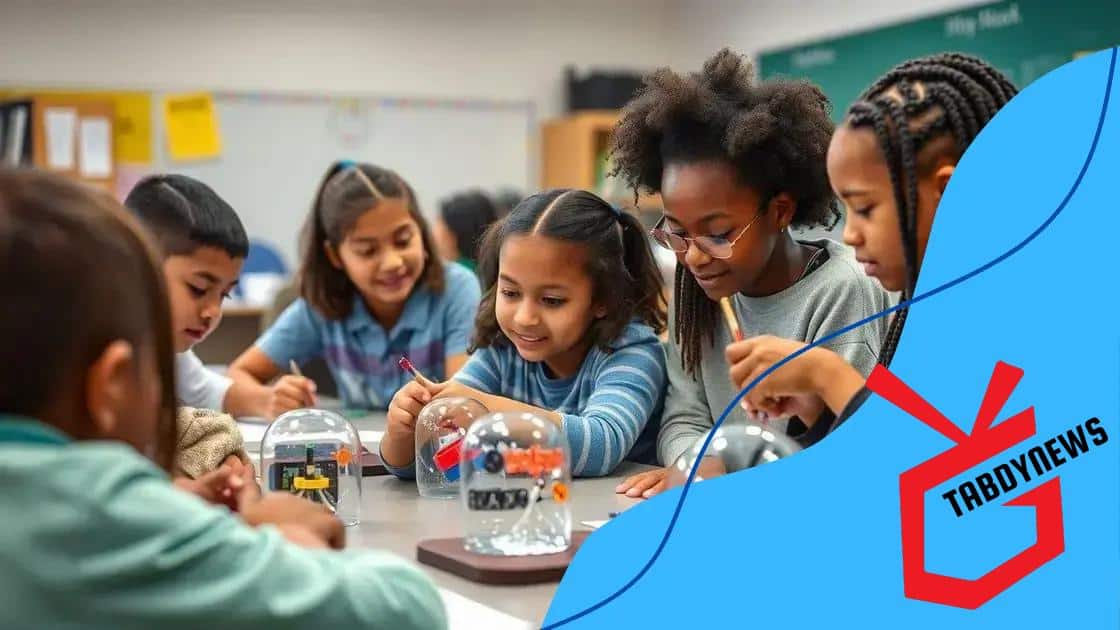STEM education equity efforts: transforming opportunities

STEM education equity focuses on ensuring all students, regardless of background, have equal access to quality education in science, technology, engineering, and math, making it essential for fostering a diverse and innovative workforce.
STEM education equity efforts are essential for ensuring every student has access to quality education in science, technology, engineering, and math. It raises important questions about how we can create more inclusive environments. Are we doing enough to bridge the gap?
Understanding STEM education equity
Understanding STEM education equity is vital for creating an inclusive environment where every student can succeed in science, technology, engineering, and math. These fields are essential for future job markets, and it’s crucial that all individuals, regardless of their background, have equal access to these educational opportunities.
What is STEM Education Equity?
STEM education equity ensures that students from diverse backgrounds receive the same support and resources in their education. This approach seeks to eliminate barriers that prevent underrepresented groups from excelling in STEM fields. Educational equity doesn’t just mean equal access but also providing tailored support that meets the specific needs of each student.
Importance of STEM Education Equity
Providing equitable opportunities can lead to:
- Increased diversity in STEM professions
- Enhanced problem-solving through varied perspectives
- Better preparedness for a technology-driven world
As we develop programs and initiatives, it’s essential to recognize the systemic challenges many students face. Factors like socioeconomic status, geography, and access to quality schools can create significant obstacles. Understanding these challenges is the first step to addressing them and ensuring that all students can thrive in STEM environments.
Moreover, schools and communities must work together to create an atmosphere where every student feels valued. Mentorship programs and workshops can expose students to STEM careers and help ignite their interest from a young age. When students see role models who look like them or come from similar backgrounds succeeding in these fields, it greatly enhances their motivation and aspirations.
Strategies for Promoting Equity
To further support STEM education equity, we can implement several strategies:
- Offer scholarships specifically for underrepresented students
- Develop after-school programs that focus on hands-on STEM activities
- Partner with local businesses to provide internship opportunities
By focusing on these strategies, we can begin to close the equity gap in STEM education. It’s not just about getting students through school; it’s about preparing them for future success in a world that increasingly relies on technology and scientific understanding.
Current challenges in STEM access
Current challenges in STEM access significantly impact the ability of many students to pursue careers in science, technology, engineering, and math. Various factors create these challenges and prevent equal opportunities for all.
Barriers to Access
Some of the major barriers include:
- Limited resources in underfunded schools
- Insufficient access to technology and equipment
- Socioeconomic factors that hinder participation
- Lack of support and encouragement from peers and family
Many students, particularly those from marginalized communities, face significant difficulties accessing quality STEM education. For example, schools in low-income areas may lack lab facilities, trained teachers, or even basic materials. These limitations restrict their ability to engage in hands-on learning experiences essential for understanding STEM concepts.
Impact of Socioeconomic Status
The influence of socioeconomic status cannot be overlooked. Students from wealthier backgrounds typically have access to better educational resources, including after-school programs, tutoring, and technology. This creates an unequal playing field where low-income students struggle to catch up.
Moreover, geographic location plays a crucial role. In rural areas, students may face challenges like fewer schools offering advanced STEM classes or extracurricular programs focused on science and technology. This geographic disparity can hinder their interest and participation in these fields.
The Role of Gender and Minority Representation
Gender and minority representation are also critical factors influencing access to STEM. Girls and students from underrepresented ethnic groups often encounter stereotypes and biases that can discourage their participation in STEM activities. Addressing these stereotypes is essential for creating an inclusive atmosphere.
Programs that target underrepresented groups can be highly effective in bridging the gap. By providing mentorship and role models who share similar backgrounds, we can inspire the next generation of scientists and engineers.
Incorporating STEM education equity initiatives can help tackle these challenges. Schools and organizations must collaborate to ensure all students have access to quality STEM education, regardless of their backgrounds.
Successful initiatives promoting equity

Successful initiatives promoting equity in STEM education play a vital role in bridging the gap for underrepresented groups. Several programs and strategies have proven effective in creating inclusive environments where all students can thrive.
Community Partnerships
One successful approach is building strong community partnerships. Collaborations between schools, local businesses, and nonprofit organizations can provide resources and support. For example, community members can volunteer their time to mentor students or provide funding for STEM equipment.
Diverse Role Models
Another key initiative is the promotion of diverse role models in STEM fields. Programs that highlight successful professionals from various backgrounds inspire students and show them that they too can succeed. When students see someone who looks like them in a STEM career, it greatly enhances their confidence and aspirations.
Moreover, mentorship programs have shown promising results. Connecting students with mentors can be transformative, providing guidance, encouragement, and practical advice. These mentors can help students navigate educational pathways and explore career options in STEM.
After-School Programs and Workshops
After-school programs and workshops focusing on hands-on STEM learning are also effective. These initiatives can spark interest in science and technology, providing students with the chance to experiment and learn outside of the traditional classroom setting.
Examples of successful initiatives include:
- Girls Who Code: a program aimed at closing the gender gap in technology
- Black Girls Code: providing education in programming and technology for young girls of color
- Project SEED: a research program that links students with mentors in scientific fields
These examples highlight how targeted initiatives can create pathways for success in STEM. It’s essential to continuously evaluate and adapt these programs to meet the changing needs of students and communities.
In addition, schools can offer scholarships and opportunities specifically designed for students from underrepresented backgrounds. This targeted outreach can help level the playing field and make STEM careers more accessible.
The role of community engagement
The role of community engagement is crucial in promoting equity in STEM education. Engaging the community helps bridge gaps and create supportive networks that empower students from various backgrounds.
Building Connections
One way community engagement works is by fostering strong connections between schools and local organizations. These partnerships can provide essential resources, mentorship, and opportunities for students. Local businesses and community leaders can contribute time and expertise, making STEM subjects more relatable and exciting.
Creating Awareness
Community initiatives can also raise awareness about the importance of STEM. Hosting events such as science fairs or tech expos allows students to showcase their talents and engage with professionals. This exposure can inspire students to pursue STEM careers, as they see tangible examples of success around them.
Moreover, programs that invite families to participate in STEM activities can strengthen ties within the community. When parents get involved, it sends a strong message about the value of education, encouraging their children to take STEM subjects seriously.
Leveraging Local Expertise
Utilizing local experts for guest lectures or workshops can enhance students’ learning experiences. Bringing in professionals from various STEM fields allows students to learn directly from those who work in the industry. This interaction can spark students’ interest and provide insights about potential career paths.
Furthermore, engaging with community members helps create a supportive environment for learning. When students feel connected to their community, they are more likely to stay engaged in school and pursue their interests. Creating mentorship programs where community members guide students can lead to long-lasting impacts.
Success Stories
Successful engagement in the community can lead to impressive results. For instance, many schools have created programs that include:
- STEM clubs that meet weekly with community volunteers
- Workshops that allow students to investigate real-world problems
- Summer camps focusing on technology and engineering for local youth
By leveraging community resources and support, students gain confidence and skills that prepare them for future challenges in STEM. Together, community engagement and educational equity can pave the way for a brighter future for all students.
Future trends in STEM education equity
Future trends in STEM education equity promise exciting changes that aim to create a more inclusive landscape for students everywhere. As technology and society evolve, so do the strategies to ensure equal access to quality STEM education.
Emphasis on Virtual Learning Platforms
One significant trend is the rise of virtual learning platforms. These platforms can provide students from diverse backgrounds with access to high-quality resources and experienced educators. By breaking geographical barriers, students in under-resourced areas can connect with mentors and courses that were previously out of reach.
Personalized Learning Experiences
The use of data-driven technologies will enable personalized learning experiences. This approach tailors educational content to meet individual student needs, helping them grasp complex STEM concepts at their own pace. As more schools adopt adaptive learning technologies, we can expect to see increased engagement and success rates among students.
Additionally, integrating social-emotional learning into STEM curricula is gaining traction. A focus on mental well-being and collaborative skills will help students navigate challenges more effectively. This holistic approach can help create a supportive environment where every student feels valued.
Focus on Underrepresented Groups
Future initiatives will likely put a stronger emphasis on supporting underrepresented groups in STEM. Programs aimed at encouraging girls and minorities to pursue STEM fields are on the rise. These initiatives aim to combat stereotypes and nurture interest from an early age.
Such efforts may include workshops, coding camps, and mentorship programs specifically designed for these demographics. Partnerships with organizations that focus on diversity can enhance the impact of these initiatives, ensuring that every student has the opportunity to thrive in STEM.
Collaboration Between Schools and Industries
Looking ahead, collaboration between educational institutions and industries is expected to increase. Schools will partner with companies to create internship opportunities and real-world problem-solving experiences. This alignment ensures that students acquire relevant skills that meet the demands of the evolving job market.
Moreover, as industries prioritize diversity and innovation, students from varied backgrounds can help drive new ideas and solutions. Preparing students for future careers in STEM fields is vital for both the students and the economy.
Overall, these trends reflect a growing commitment to achieving equity in STEM education, paving the way for a future where every student can succeed. By embracing technology, personalizing learning experiences, and fostering collaboration, we can build a strong foundation for future generations.
FAQ – Frequently Asked Questions about STEM Education Equity
What is STEM education equity?
STEM education equity ensures that all students have equal access to quality education in science, technology, engineering, and math, regardless of their background.
Why is community engagement important in STEM education?
Community engagement helps foster supportive networks, provides resources, and creates mentorship opportunities for students, enhancing their chances of success in STEM.
What are some successful initiatives for promoting equity in STEM?
Successful initiatives include mentorship programs, after-school workshops, and partnerships with local organizations that provide resources and support to underrepresented students.
What future trends can we expect in STEM education equity?
Future trends include increased use of virtual learning platforms, personalized learning experiences, and a greater focus on supporting underrepresented groups in STEM.





